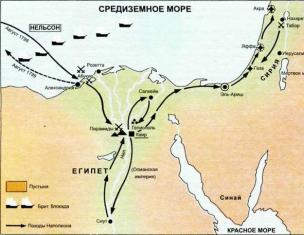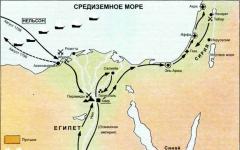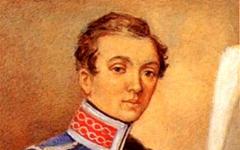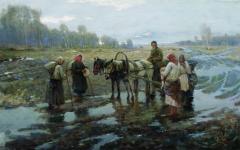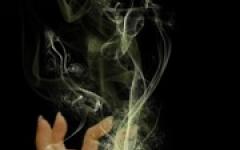Lesson topic: Analysis of the geometric shape of an object.
Lesson objectives:
- Master practical skills in analyzing the geometric shapes of objects based on their characteristic features.
- Learn to identify the simplest geometric bodies in real details.
Lesson objectives:
- Educational –
- start forming new concepts geometric body, geometric shape analysis;
- Continue to develop students’ ability to draw drawings of parts.
- Educational –
- cultivate the need to work and achieve the best results in studies.
- Developmental –
- continue the formation of logical thinking techniques (comparison, analysis, synthesis).
Equipment:
- for the teacher - three-dimensional wooden models of geometric bodies: cube, prism, pyramid, ball, cylinder, cone; table with a visual representation of the “support” part. Photo of the Nevyansk Tower.
- for students - handouts in the form of task cards containing visual images of geometric bodies; parts consisting of geometric bodies.
Lesson structure:
- Organizational part of the lesson 1–2 min.
- Updating knowledge 3–5 min.
- Learning new material 10 min.
- Reading drawings (oral work) 5 min.
- Individual graphic work 10 min.
- Summarizing what has been learned 5 min.
- Homework 3 min.
PROGRESS OF THE LESSON
Announce the topic and goals of the lesson.
– I want to start the lesson with information that, at first glance, has nothing to do with drawing. In order for the churches not to get lost in space and to be clearly visible from afar, it was necessary to find an expressive silhouette for them. The search for it led the architects to a compositional solution for churches with a tiered top made of a series of decreasing octagons.
The prototype of ancient bell towers was a military-defensive watchtower, which was built according to the traditional scheme - an eight on a four.
The leading role in the architectural appearance of the Ural city of Nevyansk, located in our region, is played by the famous “leaning” tower<Appendix 1
>. It was built in 1725 and can be seen from any street in the city. It is believed that it was originally a watchtower. The height of the tower is 57.5 meters. The tower consists of four parts: a “quadrangle”, which occupies half the height. On the quadrangle, one on top of the other, there are three “octagons”. The tower is crowned with a “tent”. In drawing language, a tower is a combination of geometric bodies. But we must find out which ones by the end of the lesson.
(Write the topic of the lesson in your notebook)
Geometric body- this is a closed part of space, limited by flat and curved surfaces.
The shape of each body has its own characteristic features.
On your desks you have cards describing these geometric bodies. Let's get to know them better.<Appendix 2
>
(The teacher shows a model of a geometric body, one of the students reads out the definition and essential features of the body from the card)
- Ex. 4 from the workbook<Appendix 3 >. Using these geometric bodies, write and draw everyday objects that have the shape of the indicated geometric bodies and their combinations.
In engineering, the shape of a part is often compared with simpler shapes - geometric bodies, and also the shapes of geometric bodies are used to describe the shape of more complex parts.
Any simple form technical details can be represented as geometric body shape(for example, the shape of a technical part “axle” can be represented as a cylinder shape - see Figure 73 in the textbook), and shape of a complex product- How combination of shapes of geometric bodies(for example, the “fork” part - see Fig. 73 in the textbook, ..., the tower, which we talked about at the beginning of the lesson). The considered approach to the study of parts is based on an analysis of its geometric shape.
Geometric shape analysis of an object is a mental dissection of an object into its constituent geometric bodies. (Write in notebook)
Let's consider how the geometric shape of an object is analyzed using a visual image of the part. We mentally divide the part into simple geometric bodies, name them and tell how they are located relative to each other in space.
For example, the “Support” part (poster on the board) consists of a rectangular parallelepiped (1) with five through cylindrical holes. In the center of the upper face of the rectangular parallelepiped there is a quadrangular prism (2) with a through cylindrical hole, the axis and diameter of which coincide with the axis and diameter of the hole of the part (1). The parallelepipeds are connected to each other by two stiffening ribs (3) in the shape of triangular prisms, which ensures their stable fastening.
By using the method of dividing a part into simple geometric bodies, you can learn to quickly, correctly read drawings and execute them competently.
Exercise: use a visual image of the part to analyze its shape (visual image of the part - poster on the board).
Answer: at the base of the part there is a rectangular parallelepiped with a through cylindrical hole in the center. Two more rectangular parallelepipeds are adjacent to it at the ends. One has a through cylindrical hole, the other has a rectangular cutout.
- Ex. 6 from the workbook<Appendix 4 >. Mentally divide these objects into geometric bodies and write down their names.
Names of elements of geometric bodies. Base, faces, edges, vertex, generatrix (the teacher shows models of geometric bodies, see the picture in the textbook).
- Ex. 7 from the workbook<Appendix 5 >. List and write down the names of the geometric bodies that make up the shape of the part.
- Now let's go back to the beginning of the lesson. As noted by the study, the Nevyansk Tower “is related to the tiered towers and bell towers of Ancient Rus', but is distinguished by its emphasized severity.” I'll remind you of her (read information from the board). <Appendix 6 >
– Let’s get acquainted with the definitions of “four”, “octagon”, “tent” - I gave several children the task of finding the meanings of these words in dictionaries. (read out, post on the board)
So how can you now, having become familiar with geometric bodies, analyze the geometric shape of the Nevyansk Tower?
Answer: the tower consists of four parts - a regular quadrangular prism and three octagonal prisms standing on top of each other. The tower is crowned by an octagonal pyramid.
– What other geometric bodies did you meet today? (Ball, cube, cone, cylinder)
– Why do we need to analyze the geometric shape of an object? ( To read and execute quickly and correctly).
Homework: in the textbook §10, pp. 58 – 61. Come up with and create a visual representation of a toy, the shape of which consists of simple geometric bodies (show example). If it is difficult to complete the drawing, you can sculpt a toy from plasticine.
Literature:
- Textbook for grades 7-8 of general education institutions “Drawing”, authors: A.D. Botvinnikov, V.N. Vinogradov, I.S. Vyshnepolsky.
- Workbook No. 3 on drawing for grade 7, authors: N.G. Preobrazhenskaya, T.V. Kuchukova, I.A. Belyaeva.
Analysis of the geometric shape of objects. Bodies of rotation. Group of geometric bodies
|
Equipment for the student: |
|
|
Accessories, textbook “Drawing”, ed. A. D. Botvinnikova §10, 11, 16, colored pencils. |
|
|
Rules for making drawings of geometric bodies. Sequence of reading a group of geometric bodies. |
|
Fixing the material
Working with cards

Fixing the material
Using colored pencils, complete the task on the card.

Geometric shape analysis -
Drawing of a part according to these two types
|
Equipment for the student: |
tools, |
|
f A4, tools |
|
|
Analyze drawings, give an accurate verbal description of the object depicted in the drawing. |

Obtaining axonometric projections of plane figures


Homework:
Repeat paragraph 7-7.2; complete the construction of table 1.
Equipment for students:
textbook "Drawing" ed. Botvinnikova A.D., workbook, drawing accessories.

 Square in dimetric projection
Square in dimetric projection
Exercise:
Construct a square in isometric projection

Triangle in dimetry Triangle in isometry

Hexagon in dimetry and isometry
Exercise:
Construct a hexagon in isometric projection
Exercise:


Axonometric projections volumetric bodies
|
Equipment for the student: |
Textbook "Drawing" ed. A.D. Botvinnikova, notebook, instruments. |
|
Accessories, textbook “Drawing”, ed. A. D. Botvinnikova page 49 table No. 2, §7-8. |
|
|
Rules for constructing axonometric projections. Methods for constructing a volumetric part in isometry. |
|
|
Construct images in axonometry starting from flat figures lying at the base of the part. Learn to analyze the resulting images. |
Review task:
Construct a geometric figure on a horizontal projection plane.



Amount (increase)

Clipping

Reinforcement task


Axonometric projection of a part with cylindrical elements
|
Equipment for the student: |
Textbook "Drawing" ed. A. D. Botvinnikova, accessories, notebook. |
|
Accessories, textbook “Drawing”, ed. A. D. Botvinnikova § 7-8. |
|
|
Rules for constructing a part with a curved surface. The general concept of “axonometry of a part.” |
|
|
Analyze the shape of the part and the resulting image. |
Ellipse –
Oval -


Algorithm for constructing an oval
1. Let's construct an isometric projection of a square - a rhombusABCD
2. Let us denote the points of intersection of the circle and the square 1 2 3 4
3. From the top of the rhombus (D) draw a straight line to the point4 (3). We get the segmentD4, which will be equal to the arc radiusR.
4. Let's draw an arc that connects the points3 And4 .
5. When crossing a segmentB2AndACwe get a pointO1.
When crossing a line D4 AndACwe get a pointO2.
6. From the received centersO1AndO2let's draw arcsR1 , which will connect points 2 and 3, 4 and 1.
Consolidating new material
! work in the workbook
Make isometric projections of the circle parallel to the frontal and profile projection planes.
Drawing and visual representation of the part
|
Equipment for the student: |
F A4, tools, textbook |
|
§12, tracing paper |
|
|
Analyze the shape of the part, build 3 types of parts and apply dimensions. |
Technical drawing
|
Equipment for the student: |
Textbook "Drawing" ed. A. D. Botvinnikova§9, accessories, notebook. |
|
Accessories, textbook “Drawing”, ed. A. D. Botvinnikova § 9 |
|
|
Rules for making technical drawings and techniques for making parts. |
|
|
Perform axonometric projections depicting flat figures. Perform technical drawing. |
Technical drawing –
Hatching methods:
Fixing the material
Complete a technical drawing of the part, two views of which are shown in Fig. 62
Projections of vertices, edges and faces of an object
|
Equipment for the student: |
Textbook "Drawing" ed. A.D. Botvinnikova, accessories, notebook, colored pencils. |
|
Accessories, textbook “Drawing”, ed. A. D. Botvinnikova §12, fA4, colored pencils. |
|
|
Methods for selecting a point on a plane. Principles of constructing edges and faces. |
|
|
Construct projections of points and faces. |
? Problem
What is a rib?
What is the top of an object?
What is the edge of an object?


Projection of a point
Practical work:
Label the projections
points on the part drawing, marked in the visual image.


Graphic work No. 9
Part sketch and technical drawing
|
Equipment for the student: |
|
|
Tools, graph paper, fA4, § 18 |
|
|
What is a sketch? Sketch rules |
|
|
Complete the sketch in the required number of types. Draw according to the sketch. |
What's called sketch?
Fixing the material
Exercise tasks
Applying dimensions taking into account the shape of the object
|
Equipment for the student: |
tools, textbook, notebook, tracing paper. |
|
Rice. 113 (1, 2, 3, 5, 8, 9) |
|
|
General rule for drawing dimensions in a drawing. |
|
Repetition and consolidation of the material covered.
Oral exercise

Practical work:

Cutouts and slices on geometric bodies
Parts elements
SLOT- a groove in the form of a slot or groove on machine parts. For example, a slot in the head of a screw or screw into which the end of a screwdriver is inserted when screwing it in.
GROOVE- an oblong depression or hole on the surface of a part, limited on the sides by parallel planes.
LYSKA– a flat cut on one or both sides of cylindrical, conical or spherical sections of a part. The flats are designed to be grabbed with a wrench, etc.
GROWTH- this is an annular groove on the rod, technologically necessary for the exit of a threaded tool during the manufacture of a part or for other purposes.
KEYWAY GROOVE- a slot in the form of a groove, which serves to install a key, which transmits rotation from the shaft to the bushing and vice versa.
CENTER HOLE- an element of a part that serves to reduce its mass, supply lubricant to rubbing surfaces, connect parts, etc. The holes can be through or blind.
CHAMFER– turning a cylindrical edge of a part onto a truncated cone.
Exercise: Instead of numbers, write the names of the part elements

Exercise: Perform an axonometric projection of the part
Practical work No. 7
"Reading Blueprints"
|
Equipment for the student: |
Textbook, notebook, sheet. |
|
Graph paper, §17 |
|
|
Master the methods of constructing 3 types, analyze the geometric shape of an object, know the names of the elements of a part. |
|
|
Analyze the drawing, determine dimensions, give an accurate verbal description |
Graphic dictation
“Drawing and technical drawing of a part based on a verbal description”
|
Equipment for the student: |
Format (notebook), tools |
|
Tools, graph paper. |
|
|
Rules for sketching |
|
|
Determine the necessary and sufficient number of types for a given part. Select the main view. Dimension. |
Option #1
Frame is a combination of two parallelepipeds, of which the smaller one is placed with a larger base in the center of the upper base of the other parallelepiped. A through stepped hole runs vertically through the centers of the parallelepipeds.
The total height of the part is 30 mm.
The height of the lower parallelepiped is 10 mm, length 70 mm, width 50 mm.
The second parallelepiped has a length of 50 mm and a width of 40 mm.
The diameter of the bottom step of the hole is 35 mm, height 10 mm; diameter of the second stage is 20 mm.
Note:
Option No. 2
Support is a rectangular parallelepiped, to the left (smallest) face of which is attached a half-cylinder, which has a common lower base with the parallelepiped. In the center of the upper (largest) face of the parallelepiped, along its long side, there is a prismatic groove. At the base of the part there is a through hole of a prismatic shape. Its axis coincides in the top view with the axis of the groove.
The height of the parallelepiped is 30 mm, length 65 mm, width 40 mm.
Half-cylinder height 15 mm, base R 20 mm.
The width of the prismatic groove is 20 mm, the depth is 15 mm.
Hole width 10 mm, length 60 mm. The hole is located at a distance of 15 mm from the right edge of the support.
Note: When drawing dimensions, consider the part as a whole.
Option No. 3
Frame is a combination of a square prism and a truncated cone, which stands with its large base in the center of the upper base of the prism. A through stepped hole runs along the axis of the cone.
The total height of the part is 65 mm.
The height of the prism is 15 mm, the size of the sides of the base is 70x70 mm.
The height of the cone is 50 mm, the lower base is Ǿ 50 mm, the upper base is Ǿ 30 mm.
The diameter of the lower part of the hole is 25 mm, height 40 mm.
The diameter of the upper part of the hole is 15 mm.
Note: When drawing dimensions, consider the part as a whole.
Option No. 4
Sleeve is a combination of two cylinders with a stepped through hole that runs along the axis of the part.
The total height of the part is 60 mm.
The height of the lower cylinder is 15 mm, the base is Ǿ 70 mm.
The base of the second cylinder is Ǿ 45 mm.
Bottom hole Ǿ 50 mm, height 8 mm.
The upper part of the hole is Ǿ 30 mm.
Note: When drawing dimensions, consider the part as a whole.
Option No. 5
Base is a parallelepiped. In the center of the upper (largest) face of the parallelepiped, along its long side, there is a prismatic groove. There are two through cylindrical holes in the groove. The centers of the holes are spaced from the ends of the part at a distance of 25 mm.
The height of the parallelepiped is 30 mm, length 100 mm, width 50 mm.
Groove depth 15 mm, width 30 mm.
Hole diameters 20 mm.
Note: When drawing dimensions, consider the part as a whole.
Option No. 6
Frame It is a cube, along the vertical axis of which there is a through hole: semi-conical at the top, and then turning into a stepped cylindrical one.
Cube edge 60 mm.
The depth of the semi-conical hole is 35 mm, the upper base is 40 mm, the bottom is 20 mm.
The height of the bottom step of the hole is 20 mm, the base is 50 mm. The diameter of the middle part of the hole is 20 mm.
Note: When drawing dimensions, consider the part as a whole.
Option No. 7
Support is a combination of a parallelepiped and a truncated cone. The cone with its large base is placed in the center of the upper base of the parallelepiped. In the center of the smaller side faces of the parallelepiped there are two prismatic cutouts. A through hole of cylindrical shape Ǿ 15 mm is drilled along the axis of the cone.
The total height of the part is 60 mm.
The height of the parallelepiped is 15 mm, length 90 mm, width 55 mm.
The diameters of the cone bases are 40 mm (lower) and 30 mm (upper).
The length of the prismatic cutout is 20 mm, width 10 mm.
Note: When drawing dimensions, consider the part as a whole.
Option No. 8
Frame is a hollow rectangular parallelepiped. In the center of the upper and lower base of the body there are two conical tides. A through hole of cylindrical shape Ǿ 10 mm passes through the centers of the tides.
The total height of the part is 59 mm.
The height of the parallelepiped is 45 mm, length 90 mm, width 40 mm. The thickness of the walls of the parallelepiped is 10 mm.
The height of the cones is 7 mm, the base is Ǿ 30 mm and Ǿ 20 mm.
Note: When drawing dimensions, consider the part as a whole.
Option No. 9
Support is a combination of two cylinders with one common axis. A through hole runs along the axis: at the top it is prismatic in shape with a square base, and then cylindrical in shape.
The total height of the part is 50 mm.
The height of the lower cylinder is 10 mm, the base is Ǿ 70 mm. The diameter of the base of the second cylinder is 30 mm.
The height of the cylindrical hole is 25 mm, the base is Ǿ 24 mm.
The base side of the prismatic hole is 10 mm.
Note: When drawing dimensions, consider the part as a whole.
Test
Graphic work No. 11
“Drawing and visual representation of the part”
Using the axonometric projection, construct a drawing of the part in the required number of views on a scale of 1:1. Add dimensions.



Graphic work No. 10
“Sketch of a part with design elements”
|
Equipment for the student: |
tools, textbook, graph paper |
|
Tools, graph paper. |
|
|
Sketch rules |
|
|
Make a sketch and put the dimensions correctly |

Draw a drawing of a part from which parts have been removed according to the markings applied. The projection direction for constructing the main view is indicated by an arrow.

Graphic work No. 8
"Part drawingctransforming its form"
|
Equipment for the student: |
tools, fA4, textbook |
|
Tools, graph paper. |
|
|
Execute drawing |



General concept of shape transformation. Relationship between drawing and markings
|
Equipment for the student: |
Textbook, notebook, graph paper, accessories |
|
Textbook pic. 151 (get to know each other), fA4 |
|
|
Analyze the form. Draw the drawing in orthogonal rectangular projection. |
Graphic work
Making a drawing of an object in three views with transforming its shape (by removing part of the object)
Complete the technical drawing of the part, making, instead of the protrusions marked with arrows, notches of the same shape and size in the same place.

Logical thinking task





Subject"Design of drawings"

Subject"Drawing tools and accessories"


Crossword"Projection"

1.The point from which the projecting rays emanate during central projection.
2. What is obtained as a result of modeling.
3. Cube face.
4. The image obtained during projection.
5. In this axonometric projection, the axes are located at an angle of 120° to each other.
6. In Greek, this word means “double dimension.”
7. Side view of a person or object.
8. Curve, isometric projection of a circle.
9. The image on the profile projection plane is a view...
Rebus on the topic"View"

Rebus

Subject"Developments of geometric bodies"

Crossword"Axonometry"
Vertical:
Translated from French as “front view”.
The concept in drawing on which the projection of a point or object is obtained.
The boundary between the halves of a symmetrical part in the drawing.
Geometric body.
Drawing tool.
Translated from Latin, “throw, throw forward.”
Geometric body.
The science of graphic images.
Unit of measurement.
Translated from Greek “double dimension”.
Translated from French as “side view”.
In the drawing, “she” can be thick, thin, wavy, etc.
Work programFrom "____" _________ 2014 Working program By drawing Grades 8 and 9 Modified based on the program... separate A4 sheets, exercises in notebooks.) 1. Sketch of the part with the required cut...
Subject. Analysis of the geometric shape of an object.
Purpose of the lesson. To teach students to confidently distinguish models of geometric bodies, name them correctly, and also mentally dissect an object into its constituent geometric bodies, followed by drawings and visual images of these bodies.
Lesson Plan . 1. Organizational part – 2 min.
2. Presentation of new material -30 min.
3. Graphic work – 12 min.
4. Homework – 1 min.
Equipment. 1 Models of geometric bodies.
2.Models of parts.
3.Presentation “Geometric bodies”
In previous lessons, we learned that depending on the complexity of the geometric shape of an object, in the drawing it can be represented by 1 projection (flat part), 2 projections or 3 projections (rectangular parallelepiped). But a rectangular parallelepiped is a simple geometric body and drawing it was not difficult.
Q. How did we construct a drawing of a rectangular parallelepiped?
A. Using rectangular projection. Mentally position the parallelepiped in a trihedral angle like this. so that the faces of the parallelepiped are parallel to the corresponding faces of the trihedral angle and projecting rays are drawn from the vertices of the parallelogram perpendicular to the projection planes. By connecting the points obtained on the projection planes, we obtained a drawing of a rectangular parallelepiped in 3 views.
What if we need to build a drawing of a table, chair, TV, or other objects around us? Or a drawing of one of the parts presented in front of you? (demonstrated details). You must first determine what simple geometric bodies this part consists of, i.e. analyze its geometric shape.
Students open their notebooks and write down the date and topic of the lesson. "Analysis of geometric part shapes ».
Q. What simple geometric bodies do you know?
A. Rectangular parallelepiped, sphere, cone, etc.
Let's consider straight prism. (a prism model is demonstrated). This is a polyhedron with 2 faces - polygons (prism bases), and the remaining faces - rectangles located perpendicular to the base. If the base is a regular polygon in which all sides are equal and all interior angles are equal, then the prism is called regular.
There are different types of prisms, but in the school drawing course we will consider the correct straight prism. Depending on which polygon lies at the base of the prism, it will be named accordingly. (models are demonstrated regular triangular, hexagonal prisms).
The well-known rectangular parallelepiped is a special case of a prism .(a model of a rectangular parallelepiped is demonstrated).
Q. What geometric figures are its faces?
O. Rectangles.
This means that a rectangular parallelepiped is a hexagon, all of whose faces are rectangles and the opposite faces are parallel in pairs. It has 8 vertices, 12 edges, 6 faces.
Cube- a rectangular parallelepiped, all sides of which are equal. ( demonstrated cube model).
This is a polyhedron, one of whose faces is a polygon (the base of the pyramid), and the remaining faces are isosceles triangles with a common vertex. We will consider a regular pyramid.
Q. Why is it correct?
A. 1. The base is a regular polygon. 2. The height of the pyramid (the perpendicular dropped from the top of the pyramid to the base) passes through the center of the base. 3. Side faces are isosceles triangles.
Depending on which polygon lies at the base, the pyramid is called accordingly.( regular triangular and quadrangular pyramids are demonstrated) .
If the top of the pyramid is cut off with a plane. parallel to the base, we get a truncated pyramid .(a model of a truncated pyramid is demonstrated).
So, the considered geometric bodies (prisms and pyramids) are polyhedra.
We looked at models of polyhedra, and here is what their visual images look like. Students name the polyhedra presented on the slide.
Let's consider another group of geometric bodies: cylinder, cone, ball.
Cylinder– a geometric body bounded by a closed cylindrical surface and two parallel planes cutting it (the base of the cylinder).
Q. What shapes are the bases of a cylinder?
(cylinder on display)
Cone– a geometric body limited by the surface of a circular cone and a plane containing a guide circle. For a straight cone, the perpendicular from the top of the cone to the base passes through the center of the circle (cone demonstration).
truncated cone(demonstration of a truncated cone).
Ball– a geometric body bounded by a spherical surface. ( demonstration of the ball).
A cone, a cylinder and a ball are bodies of revolution because all of them are obtained by rotating flat figures around an axis: a right triangle around one of the legs, a rectangle around one of the axes of symmetry, a circle around its diameter, respectively.
Notebook entry: (slide No. 4)
Geometric bodies.
![]()
Polyhedra Solids of revolution
1. Prism (rectangular parallelepiped 1. Cone
2. Pyramid 2. Cylinder
Geometric bodies are found not only in the objects around us, but also at the basis of the shape of machine parts. Students determine the shape of an axle, roller, key, gasket.
But not all parts have such a simple shape. Most of them have more complex shapes and their shape is not determined by one geometric body. Students analyze the geometric shape of the roller and sleeve.
It is more difficult to understand the shape of a more complex part. Students analyze the geometric shape of the part presented on the slide.
Q. How did we determine the geometric shape of the part?
A. Mentally dissected the part into simple geometric bodies.
Writing in a notebook: analysis of the geometric shape of an object is the mental division of an object into its constituent geometric bodies.
Students are asked to analyze the geometric shape of the parts presented in the picture in the textbook.
So, we have learned to analyze the geometric shape of objects. But in order to make a drawing of this object, you need to know how drawings of geometric bodies are made. In the notebook: drawings and visual images of geometric bodies.
Q.What is called part drawing?
A. This is a projection of the part onto a plane.
Q. What types of visual images do you know?
O. Axonometric projection and technical drawing. (students define them, note their common features and differences).
In the notebook:
1. Cube (a=40).
2. Rectangular parallelepiped (40 x 20 x 70).
Before performing graphic work, a “physical training minute” (gymnastics for the eyes) is carried out.
Summing up the lesson. In today's lesson, we got acquainted with various models of geometric bodies, learned to name them correctly, and also learned to analyze the geometric shape of a part and began to make drawings and visual images of these bodies.
1. Q. “This” can be obtained by rotating the rectangle around its axis. It looks like a can or a barrel.
O. Cylinder.
2. Q. “This” can be obtained by rotating a right triangle around an axis. It looks like an astrologer's cap.
3. Q. You can get a lot of “this” by buying “Rondo” - fresh breath and removing the packaging.
O. Cylinders.
4. Q. “This” can be obtained by rotating half a circle around an axis. All children, and not only children, love to play with this.
Homework. Make a drawing and visual representation of a rectangular parallelepiped.
>>Drawing: Analysis of the geometric shape of an object
In engineering, the shape of a part is often compared with simpler shapes - geometric bodies, and also the shapes of geometric bodies are used to describe the shape of more complex parts.
Any simple shape of a technical part can be represented as the shape of a geometric body (for example, the shape of a technical part “Axle” can be represented as the shape of a cylinder), and the shape of a complex product can be represented as a combination of shapes of geometric bodies (for example, the shape of a part “Plumb” is a combination cylinder and cone). The considered approach to the study of parts is based on an analysis of its geometric shape.
Analysis of the geometric shape of an object- this is the mental division of an object into its constituent geometric bodies.
Let's consider how the geometric shape of an object is analyzed using a visual image of the “Support” part (Fig. 141).
We mentally divide the part into simple geometric bodies, name them and tell how they are located relative to each other in space. For example, the “Support” part consists of a rectangular parallelepiped (1) with five through cylindrical holes. In the center of the upper face of the rectangular parallelepiped there is a quadrangular prism (2) with a through cylindrical hole, the axis and diameter of which coincide with the axis and diameter of the hole of the part (1). The parallelepipeds are connected to each other by two stiffening ribs (3) in the shape of triangular prisms, which ensures their stable fastening.

By using the method of dividing a part into simple geometric bodies, you can learn to quickly, correctly read drawings and execute them competently.
Questions and tasks
1. What is the analysis of the geometric shape of objects? What is its significance?
2. Based on the visual image of the part (Fig. 142), analyze its shape.
3. Determine which geometric bodies made up the shape of the “Stem” part shown in Fig. 143.
4. Using the drawing of the part (Fig. 144), analyze its shape. Answer additional questions:
- What do the thin intersecting lines on the projection of the product mean?
- Which element (part) of the product does the notation 2x45° refer to?
- What are the overall dimensions of the part?

N.A. Gordeenko, V.V. Stepakova - Drawing., 9th grade
Submitted by readers from Internet sites
Prepared:
2005 – 06 academic year
Topic: Analysis of the geometric shape of an object
Goals : recall geometric bodies, give the concept of analyzing the shape of an object; teach students to find simple geometric bodies in any technical detail, read and construct their drawings; develop spatial concepts and thinking; cultivate a sense of time and responsibility in the team.
Lesson type: lesson of learning new material.
Methods: quiz, conversation, reading and completing drawings, exercises, working with a textbook.
Material support: models of geometric bodies, formation of geometric bodies, technical details.
H O D U R O K A.
I.Organizational part.
II.Message of the topic, lesson objectives
Lesson topic:"Analysis of the geometric shape of an object." We must remember the basic geometric bodies, learn how to construct their projections, and use this information when reading the drawing. (slide number 1)
III.Learning new material.
1. Conducting a quiz "Remember geometric bodies».
Teacher: Before considering a new topic, we organize a quiz “Remember geometric bodies” between three teams (rows).
Task – remember geometric bodies. I will lean on. guys, based on your knowledge from the course in geometry, drawing technology. The team that gives the most correct answers will win. Are you ready?
I'm starting a quiz.
Question to team 1: What is this geometric body called? (Cube demonstration). Conclusion. (slide number 2)
Question 11 to the team: Name this geometric body. (Demonstration of a hexagonal prism). Conclusion. (slide number 3)
Question 111 to the team: What is the name of this geometric body? (Demonstration of a quadrangular pyramid.) Conclusion. (slide number 4)
Question to team 1: What geometric body is formed when a rectangle rotates? Conclusion. (slide number 5)
Question 11 to the team: What geometric body is formed when a triangle rotates? Conclusion. (slide number 6)
Question 111 to the team: What geometric body is formed when a trapezoid rotates? Conclusion. (slide number 7)
Question for everyone: Shown are ski poles with points in the form of a cone, a prism and a pyramid. Their frontal projections are the same, but their horizontal ones?
1 team – 1 pic.
2nd team – 2nd pic.
3rd team – 3rd pic.
Conclusions. (slide number 8)
All teams coped with the quiz questions and showed good knowledge of geometric bodies.
2. Conversations about the analysis of the geometric shape of objects.
The names of geometric bodies were originally the names of specific objects that have a shape more or less close to the shape of a given body. So the word " cylinder " meant roller, skating rink, word " cone » - pine cone, word " prism » – sawn(meaning a sawn log), “ pyramid " comes from the word " purees With", which the Greeks called the Egyptian pyramids. Some scientists suggest that the shape of the pyramid, in turn, was suggested to the Egyptians by the promising convergence of the sun's rays. This light effect can sometimes be observed when the sun appears through a break in the clouds. The ball is bounded by a surface called sphere, from the Greek word « sfeira" - ball.(slide no. 9-10)
Man studied the shape of objects in the process of his practical activities.
Take a closer look at geometric bodies; the shape of each body has its own characteristic features, by which we distinguish a cylinder from a cone, and a cone from a pyramid. We say " cube"and everyone imagines its shape. We say " ball“, and again we have a very specific image.
Let's consider some features of geometric bodies.
Geometric bodies are divided into bodies of revolution and polyhedra
What bodies of rotation do you know? Conclusion.
Cylinder, cone and truncated cone have the following elements:
axis of rotation, base, generatrix, cylinder - cylindrical surface, cone - conical surface, cone also has an apex. (slide no. 11-12)
Ball- axis of rotation, center, equator, meridian. (slide number 13)
What geometric solids from polyhedra do you know? Conclusion.
Parallelepiped: rectangular, cube has vertices, face, edge. (slide No. 14
Prism: base, top, edge, face. (slide number 15)
Pyramid, truncated pyramid-vertex, edge, face. (slide number 16)
What elements are common to these geometric bodies? Conclusion.
And so, we have discussed with you the elements of geometric bodies by which we distinguish them from each other.
Depending on the base, the prism and pyramid may be different. If the base is a hexagon, then the prism and pyramid are called hexagonal; if a triangle, then a triangular prism or pyramid.
Question: Take a closer look at the objects around us. What can you notice? (Students' answers)
Generalization. That's right, objects have the shape of geometric bodies or represent a combination of them.
Parallelepiped, prisms – residential multi-storey building, village house;
Ball - ball;
Cylinder – drum;
Cone - fire bucket;
Truncated cone – flower pot, bucket; (slide number 17)
The shape of machine parts and mechanisms is also based on geometric bodies.
Take a look at the table. (slide number 18)
Various details are shown here. Some of them are of the simplest form.
Question: What shape are the axle and roller? What is the shape of the gasket?
(Students' answers).
Generalization. About such parts as the axle and roller, we will say that they are cylindrical, and about the gasket - it is prismatic.
Other parts have a more complex shape; they are a collection of geometric bodies. For example: a roller is formed by adding another smaller cylinder to a cylinder. And the bushing is cylindrical, from which another cylinder of smaller diameter has been removed.
It is more difficult to understand the shape of a more complex part, such as a fork, from a drawing.
Question: What is the easiest way to determine the shape of objects from a drawing? (Students' answers).
Generalization. To do this, a complex-shaped part is mentally dissected into its individual constituent parts, which have the shape of various geometric bodies.
Definition: the mental division of an object into its constituent geometric bodies is called analysis of geometric shape. (slide number 19)
An image of the support is given. What is its shape? (slide number 20)
It is composed of a rectangular parallelepiped, two half-cylinders and a truncated cone. The part has a cylindrical through hole. After such “dismemberment” the shape of the part is easier to determine.
3.Primary consolidation: oral questioning.
Questions and tasks for consolidation:
Figure 1(slide number 21)
What geometric bodies are depicted?
Is there any rotation in the image of the body?
If there are, name them.
Which geometric body is closest to us?
Which geometric bodies touch each other?
Figure 2(slide number 22)
What geometric bodies does this composition consist of?
Determine the top view of this composition.
IV. Consolidation of the studied material. (slide number 23)
Practical exercise
Task: using a visual image of the part, draw it in the required number of views.
V. Homework (slide number 24)
VI. The final part. (slide number 25)
Let's summarize the lesson by filling in the empty columns of the text with the necessary words and terms.
1. Every detail can be mentally ________________
for individual _____________
2. This process is called ___________________
3. Only two geometric bodies differ in identical projections - these are __________________ and ____________________

